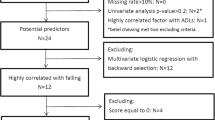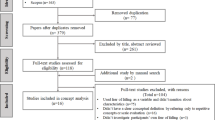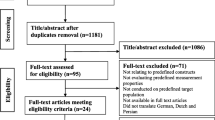Abstract
Aboriginal elders falls have been a widely discussed topic; however, factors such as emotional and physical functions, and social and cultural backgrounds are lacking. Most studies focusing on fall correlations concentrate on medical institutions or non-tribal community areas. Few studies focus on falling of elders in mountainous areas. Applying grey relational and multi-objective decision making to predict the prevalence of falls and associated risk factors for aboriginal elders is the purpose of this study. We targeted the Atayal and Tsuo aboriginal elders in central Taiwan, involving 160 members settled in mountainous townships in Taiwan. For this research study, the components are as follows: The grey theory predicts and evaluates the commonly used fall risk assessment tools, that is, quantative questionaires include: (1) focused history: medication history and Brief Symptom Rating Scale questionnaire, BSRS-5; (2) functional Assessment: ADL (Barthel Index) and IADL; (3) prevention of falls health beliefs; and (4) prevention of falls self-efficacy. With qualitative and in-depth interviews, 18 tribal elders, 55 years and above, were interviewed: 9 from the Atayal and 9 from the Tsou. Based on the Nvivo 12.0 data analysis software, this study concluded that the most predictable fall risk assessment tool is Downton Fall Risk Index (weighting: 0.8657), followed by BSR-5 (weighting: 0.5701), prevention of falls health beliefs (weighting: 0.448), Barthel scale (weighting: 0.4296), IADL (weighting: 0.1661), prevention of falls self-efficacy (weighting: 0.1391) and medical history (weighting: 0.0615). Further, qualitative results indicated that the issue of health inequalities under the influence of ethnic culture, including physical and disease characteristics, tend to be more than the proportion of heart and hypertension diseases, healthy behaviors such as unbalanced diet, cultural beliefs in gender division of labor and ethnic communication barriers and lack of cultural adaptability care resources. The risky tribal environment of mountainous areas is a major factor that leads to falls. The results provide an accurate assessment tool suitable for Taiwanese aboriginal elders’ falls for future medical policy making and fall prevention intervention in cultural safety.



Similar content being viewed by others
References
Abualigah LMQ (2019) Feature selection and enhanced krill herd algorithm for text document clustering. Stud Comput Intell 861:92–98
Abualigah LMQ, Hanandeh ES (2015) Applying genetic algorithms to information retrieval using vector space model. Int J Comput Sci Eng Appl 5(1):19
Abualigah LM, Khader AT (2017) Unsupervised text feature selection technique based on hybrid particle swarm optimization algorithm with genetic operators for the text clustering. J Supercomput 73(11):4773–4795
Abualigah LM, Khader AT, Al-Betar MA, Hanandeh ES, Alyasseri ZA (2017a) A hybrid strategy for krill herd algorithm with harmony search algorithm to improve the data clustering. Intell Decis Technol 12(1):3–14
Abualigah LM, Khader AT, Hanandeh ES, Gandomi AH (2017b) A novel hybridization strategy for krill herd algorithm applied to clustering techniques. Appl Soft Comput 60:423–435
Abualigah LM, Khader AT, Hanandeh ES (2018a) A combination of objective functions and hybrid Krill herd algorithm for text document clustering analysis. Eng Appl Artif Intell 73:111–125
Abualigah LM, Khader AT, Hanandeh ES (2018b) Hybrid clustering analysis using improved krill herd algorithm. Appl Intell 48(11):4047–4071
American Geriatrics Society, British Geriatrics Society and American Academy of Orthopaedic Surgeons Panel on Falls Prevention (2001) Guideline for the prevention of falls in older persons. J Am Geriatr Soc 49:664–672
Australian Institute of Health and Welfare (2011) 2010 National drug strategy household survey report. Australian Institute of Health and Welfare, Canberra
Beauchet O, Allali G, Annweiler C, Berrut G, Maarouf N, Herrmann FR, Dubost V (2008) Does change in gait while counting backward predict the occurrence of a first fall in older adults. Gerontology 54:217–223
Burns ER, Stevens JA, Lee R (2016) The direct costs of fatal and non-fatal falls among older adults-United States. J Saf Res 58:99–103
Cahn-Weiner DA, Farias ST, Julian L, Harvey DJ, Kramer JH, Reed BR, Chui H (2007) Cognitive and neuroimaging predictors of instrumental activities of daily living. J Int Neuropsychol Soc 13(05):747–757
Castles S (2004) Factors influencing falls among nursing home residents. In: the Canadian Association on Gerontology’s pre-conference workshop. Victoria, BC
Chang CH, Guo JL, Lin E, Tsai YJ (2010) Effects of multifactorial fall prevention program on fall and health-related quality of life in the elderly. J Healthy Life Success Aging 1(2):1–15
Cheng CS (2008) Fingerprint recognition using discrete wavelet transformation and grey relational analysis. J Grey Syst 20(2):93–108
Chiou HC, Chen YC, Mau LW, Shiao SH, Hong WL, Huang MS (1997) An evaluation of the reliability and validity of the Chinese-version oars multidimensional functional assessment questionnaire. Chin J Public Health 16:119–132
Chuang YF, Sung HC, Lin LP (2005) Health status and health resource utilization among older people in rural mining area. Tzu Chi Nurs J 4(1):34–41
Chung CH, Pai L, Wu PH, Lai C, Chien WC (2010) Trends of fall mortality in Taiwan, 1986–2007. Chin J Occup Med 17(3):151–162
Coronado VG, Xu L, Basavaraju SV (2011) Surveillance for traumatic brain injury-related deaths-United States, 1997–2007. MMWR Survdll Summ 60:1–32
Deng J (1989) Introduction to grey system theory. J Grey Syst 1:1–24
Farias ST, Park LQ, Harvey DJ, Simon C, Reed BR, Carmichael O, Mungas D (2013) Everyday cognition in older adults: associations with neuropsychological performance and structural brain imaging. J Int Neuropsychol Soc 19(4):430–441
Guo JL, Chang CH, Lin E, Tsai YJ (2009) Fall Prevention Program for Community-dwelling Seniors and Elderly Institutionalized Residents. J Healthy Life Success Aging 1(1):53–67
Harvey L, Close J (2013) Trends in fall-related hospitalisations, persons aged 65 years and over 1998–99 to 2011–12. Falls and Injury Prevention Group, Neuroscience Research Australia
Hsu KT, Yan TM, Liu PW (2006) A study on the annualized medical expense prediction model of the bureau of national healthy insurance-the application of the grey prediction theory. Syst Man Cybern 1:764–769
Huang HC (2004) A check list for assessing the risk of falls among the elderly. J Nurs Res 12(2):131–142
Indigenous Peoples Committee (2014) Report on the promotion of gender mainstreaming. Author, Taipei City, Taiwan, ROC
Isberner F, Ritzel D, Sarvela P, Brown K, Hu P, Newbolds D (1998) Falls of elderly rural home health clients. Home Health Care Serv Q 17:41–51
Jamieson LM, Roberts-Thomson KF (2007) Hospitalized head injuries among older people in Australia, 1998/1999 to 2004/2005. Inj Prev 13(4):243–247
Kenny R, Rubenstein LZ, Tinetti ME, Brewer K, Cameron KA, Capezuti L (2011) Summary of the Updated American Geriatrics Society/British Geriatrics Society clinical practice guideline for prevention of falls in older persons. J Am Geriatr Soc 59:148–157
Kvelde T, Lord SR, Close JCT, Reppermund S, Kochan NA, Sachdev P, Brodaty H, Delbaere K (2015) Depressive symptoms increase fall risk in older people, independent of antidepressant use, and reduced executive and physical functioning. Arch Gerontol Geriatr 60:190–195
Lawton MP, Brody EM (1969) Assessment of older people: self-maintaining and instrumental activities of daily living. Gerontologist 9:179–186
Lee L, Lin S, Yen CF, Chuang JL (2016) Comparing the health needs of older aboriginal and older ethnic Chinese individuals in Taiwan. J Nurs Manag 63(2):58–68
Leininger MM, Mcfarland MR (2005) Culture care diversity and universality: a worldwide nursing theory. Jones & Bartlett Learning, Burlington
LoGiudice D, Smith K, Atkinson D, Dwyer A, Lautenschlager N, Almeida O et al (2012) Preliminary evaluation of the prevalence of falls, pain and urinary incontinence in remote living Indigenous Australians over the age of 45 years. J Intern Med 42(6):102–107
Low ST, Balaramam T (2017) Physical activity level and fall risk among community-dwelling older adults. J Phys Ther Sci 29:1121–1124
Lukaszyk C, Coombes J, Keay L, Sherrington C, Tiedemann A, Broe T, Lovitt L, Ivers R (2016) Fall prevention services for older Aboriginal people: investigating availability and acceptability. Public Health Res Pract 26(5):e2651659
Lung FW, Lee MB (2008) The five-item brief-symptom rating scale as a suicide ideation screening instrument for psychiatric inpatients and community residents. BMC Psychiatry 8:53
Ministry of Health and Welfare (2016) Statistics on death caused by the Ministry of Health and Welfare of Taiwan. Taiwan, ROC
M.O.I (2018) Population of indigenous people by gender and tribal affiliation. Department of Household Registration. Taiwan. https://gis.ris.gov.tw/dashboard.html?key=B08
Mojtaba M, Alinaghizadeh H, Rydwik E (2018) Downton Fall Risk Index during hospitalisation is associated with fall-related injuries after discharge: a longitudinal observational study. J Physiother 64:172–177
Montali F, Campaniello G, Benatti M, Rastelli G, Pedrazzoni M, Cervellin G (2015) Impact of different drug classes on clinical severity of falls in an elderly population: epidemiological survey in a trauma center. J Clin Gerontol Geriatr 6(2):63–67
Murphy T, Pokhrel P, Worthington A, Billie H, Sewell M, Bill N (2014) Unintentional injury mortality among American Indians and Alaska natives in the United States, 1990–2009. Am J Public Health 104:S470–S480
Norton R (1999) Preventing falls and fall-related injuries among elderly. Australas J Ageing 18(4):160–166
Olsson Möller U, Kristensson J, Midlöv P, Ekdahl C, Jakobsson U (2012) Predictive validity and cut-off scores in four diagnostic tests for falls-A study in frail older people at home. Phys Occup Ther Geriatr 30:189–201
Rosendahl E, Lundin-Olsson L, Kallin K (2003) Prediction of falls among older people in residential care facilities by the Downton index. Aging Clin Exp Res 15:142–147
Rubenstein LZ, Josephson KR (1996) Osterweil D: falls and fall prevention in the nursing home. Clin Geriatr Med 12:881–902
Scott V, Votova K, Scanlan A, Close J (2007) Multifactorial and functional mobility assessment tools for fall risk among older adults. Age Ageing 36:130–139
Solomon DH, Mogun H, Garneau K, Fischer MA (2011) Risk of fractures in older adults using antihypertensive medications. J Bone Miner Res 26:1561e7
Stevens JA, Corso PS, Finkelstein EA, Miller TR (2006) The costs of fatal and non-fatal falls among older adults. Inj Prev 12(5):290–295
Teng YW (2006) A study of the risk factors causing fall of the elderly on aboriginal community residents at Jhuosi in Hualien.(Unpublished master’s thesis). Tzu Chi University, Hualien City, Taiwan, ROC
Tseng TJ, Wu YS, Tang JH, Chiu YH, Lee YT, Fan IC, Chan TC (2019) Association between health behaviors and mood disorders among the elderly: a community-Based cohort study. BMC Geriatr 19:60
Wang MH (2003) Exploring the social characteristics of the Ataya multiple meanings of Gaga. Taiwan J Anthropol 1(1):77–104
Wang C (2006) Constructing a decision-making model for quality function deployment using grey relational analysis. J Des 11(4):43–58
Wei TS, Chang LW, Liu PT (2007) Gait asymmetry, ankle spasticity and depression as independent predictors of accidental falls in stroke elderly. Proceeding of the 4th World Congress of the ISPRM. Seoul, Korea, pp 39–40
Wen KL, Huang Y, Zhang W, Zhang T, You ML, Lai J (2003) The grey relational model method and application. Gau Lih Book Company, Taipei
Wen KL, Zhao ZG, Zhang HG, Chen XY, Wen HZ (2009) Grey theory. Wunan Book Company, Taipei City
Wong AK, Lord SR, Sturnieks DL, Delbaere K, Trollor JN, Close JC (2013) Angiotensin system-blocking medications are associated with fewer falls over 12 months in community-dwelling older people. J Am Geriatr Soc 61:776–781
World Health Organisation (2007) WHO global report on falls prevention in older age. WHO, Geneva, 5
Wu JH, Chen CB (1999) An alternative form for grey correlative grades. J Grey Syst (Uk) 11(1):7–12
Wu H, Deng J, Wen K (1996) Grey analysis. Gao Li Book Company, Taipei
Funding
This study was partially sponsored by the Health Promotion Adminstration, Ministry of Health and Welfare (Contract No. B1070610) and the Ministry of Science and Technology, Taiwan (Contract No. MOST 108-2420-H-025 -003 -MY2). Authors express our thanks for financial support.
Author information
Authors and Affiliations
Corresponding author
Ethics declarations
Conflict of interest
The author declared no potential conflicts of interest with respect to the research, authorship and/or publication of this article.
Ethical approval
The ethical review has been approved as CRB-107-042 and IRB024-BE.
Additional information
Communicated by Mu-Yen Chen.
Publisher's Note
Springer Nature remains neutral with regard to jurisdictional claims in published maps and institutional affiliations.
Rights and permissions
About this article
Cite this article
Huang, HC., Tsai, TF. & Subeq, YM. Using grey relational analysis and grey integrated multi-objective strategy to evaluate the risk factors of falling of aboriginal elders in Taiwan. Soft Comput 24, 8097–8112 (2020). https://doi.org/10.1007/s00500-019-04178-x
Published:
Issue Date:
DOI: https://doi.org/10.1007/s00500-019-04178-x




